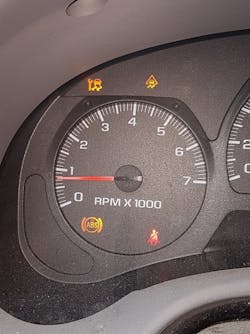The anti-lock braking system (ABS) is certainly not a new feature on the modern vehicle. The development of the ABS has continued and is now heavily integrated into vehicle operation.
If we look at the 2021 Ford F150 V6 2.7L, there are as many as 16 systems/subsystems (depending on the vehicle options) that are considered part of the ABS. There is the ABS, auto hold, drive away brake release, electronic brake force distribution, electric parking brake control, electronic stability control, emergency brake assist, hill descent control, hill start assist, roll stability control, selectable drive modes, adaptive cruise control, collision avoidance, traction control, trailer sway control and torque vectoring control.
The handling and control of the vehicle is now deeply combined with the ABS system, and all these subsystems are using wheel speed sensor (WSS) data gathered by the ABS system to make critical vehicle control system decisions. (Note: The WSS is often referred to as the ABS sensor, but for this article I will refer to it as the WSS.)
Early ABS only needed to know the speed of the wheels on the vehicle to make its decisions. These first systems only wanted to prevent wheel lockup during braking. The passive WSS supplied that data to the ABS control module. The passive WSS is a two-wire, analog, variable reluctance (VR), AC-generating sensor. The passive WSS sensor was mounted near a rotating reluctor ring (axle tone ring) and generated an AC voltage signal that was interpreted by the ABS module as a wheel speed. The passive WSS produces a signal output that will increase in both frequency and amplitude as the reluctor speed increases. The passive WSS is robust, cheap to produce and uses proven technology, but the passive WSS has three significant limitations. Passive WSS sensors are not capable of detecting the wheel’s direction. They lack the ability to accurately detect low wheel speeds (typically below 3 mph) and are very sensitive to air gap for proper operation.
Today’s complex braking systems and the various subsystems involved require more accurate wheel speed data. The ABS needs to know, very precisely, the wheel’s speed, down to zero (not moving) and it also needs to know the direction the wheel is rotating (forward or backward).
There have been two active WSS designs used so far: the three-wire, Hall-effect, and the magneto resistive sensor, in two distinct variations.
The Hall-effect sensor active WSS design is easily identified by its distinct three-wire hookup (power, ground and output) and could detect lower wheel speeds. If the reluctor was shaped properly it could even detect wheel rotation. But the Hall-effect WSS was sensitive to temperature and the harsh brake environment, so it was used in very limited circumstances.
The magneto resistive sensor active WWS design detects the changes in magnetic flux and is the preferred design. Each of the magneto resistive sensors will have a small integrated circuit (module) built into the body of the sensor. This module will output the WSS data (wheel speed and rotational direction) in a digital, square wave output. The active WSS is small, light, handles vibration and temperature fluctuations, isn’t sensitive to changes in air gap (they can tolerate a wide air gap) and is tolerant of electromagnetic interference.
The first design of active WSS magneto-resistive sensor uses a toothed tone ring like the passive WSS uses. The sensor body will have a magnet that is wrapped with a coil of wire forming a sensing circuit. An integrated circuit in the sensor will try to maintain a constant current in the sensing circuit, using voltage fed from the ABS control module. As the wheel rotates, moving the tone ring past the magnet in the sensor, the changes in the magnet flux will change the circuit’s resistance, and this change in resistance will change the current flow through the circuit. The sensor’s integrated circuit will interpret these changes in resistance as a high and low signal and process the information, so it can send both a high and low digital signal to the ABS module. The ABS module will look at the frequency of this output and then calculate the wheel speed.
The second design of active WSS (the one most used today) still relies on detecting the changes of a magnetic flux, but in this design the magnet is moving. There will not be a toothed tone ring on this type of active WSS.
The wheel hub or bearing assembly will have a unique magnetic encoded reluctor, often incorporated into the outer rubber seal of the wheel bearing. This encoded reluctor is made of a special ring of carefully arranged magnets in alternating north/south pole position, embedded in the rubber seal, which will move past the active WSS.
As the wheel turns, the active WSS will be subjected to the alternating north/south magnets and interpret these magnetic flux changes. Inside the active WSS there are two sensing elements that are mounted side-by-side and the needed integrated electronics, fed power from the ABS module. Each of the sensing elements will detect the presence of the magnetic field from the magnets mounted in the reluctor and will convert this magnetic field detection to a digital high and low signal output. This style of active WSS is often referred to as the dual-element active wheel speed sensor.
The frequency of the high and low switching will be interpreted as wheel speed, and the sensing elements are always providing signals so a stationary or stopped wheel is easily detected.
Since the sensing elements are mounted side-by-side, in the sensor tip, the two voltage signals they generate will always be slightly out of phase. As one sensor signal rises or falls, it will be just a few degrees after the other sensor. This is how this type of active ABS WSS can detect the direction of a wheel’s rotation.
Before we start a diagnostic on an ABS WSS issue or failure, we need to establish what type of WSS we are dealing with. A common mistake when diagnosing an ABS WSS issue is the assumption that all two-wire sensors are going to be the same. But remember there are passive and active ABS WSS and most of them will have two wires. The dual-element active WSS will lack a toothed tone ring so it’s straight forward to identify.
Wiring diagrams and service information will typically not tell the technician the type of WSS they are diagnosing. The best way to decide if you are unsure about the sensor type is to measure the voltage at the ABS WSS connector. The active sensors will have a voltage of 5V to 12V being supplied to the sensor from the ABS controller. Be careful when testing for this voltage, as some vehicles (Honda/Acura) will quickly detect an opening in the circuit if the WSS is unplugged and stop supplying that voltage until the ignition is cycled. If the testing reveals a voltage signal, we are dealing with an active type WSS.
It is important to remember that we cannot check the resistance of an active type WSS sensor, like we did with a passive WSS. The active type of WSS requires a tiny current supplied by the ABS control module through a resistor (in the ABS module) for operation. Testing the resistance of an active WSS could possibly result in wrong or confusing readings and even possible damage to the sensor itself.
Now that we have identified the type of WSS sensor that we are diagnosing, there are several ways we can diagnose the sensor’s output. Before any diagnostics take place, ensure the ignition is switched “ON” as an active WSS needs power from the ABS module. The use of a scan tool is going to be necessary and is the usual starting point for almost all diagnostics today. We can look for and retrieve any diagnostic trouble codes that may aid our diagnostics. Always perform a full system, full module scan, because these systems are so integrated, the codes or data you are looking for may not be under the ABS section. The scanner will also provide the needed live data that will aid in diagnostics.
We can use the scan tool and watch the wheel’s speed data, but the data on the scan tool may be buffered and hide the issue, especially if the issue is intermittent. The active WSS will output a digital square wave when the wheel is rotated. This signal can be detected and analyzed using a scope (the preferred method), micro current amp clamp or DVOM. When evaluating the output of an active WSS, only the frequency of the signal output (when displayed on the scope) will change when the wheel is turned.
The square wave output displayed on the scope will be approximately 0.6V. You can also assess the output using a DVOM and watch for the 0.6V voltage change or use a micro-amp clamp and watch for a 14mA to 7mA change either on the scope or on the DVOM display, as the wheel is turned. Using a scope will be the best bet for proper active WSS operation verification. It will quickly show the sensor output. If the active WSS is using a tone ring it will expose physical issues such as blocked, rust-filled or damaged teeth or cracks. If the active WSS is using the dual element type sensor it will show missing or damaged magnetic reluctor sections, and this is very helpful when the reluctor is not visible.
Today’s vehicle systems are heavily integrated, and the ABS is a perfect example. But the proper functioning of the braking system and all the other systems involved are relying on correct WSS speed and wheel direction information. Proper diagnostics of a WSS issue will rely on the ability to recognize what type of sensor we are diagnosing and how it functions.
And when diagnosing an ABS WSS issue, don’t underestimate the power of the visual inspection. When diagnosing an active WSS concern on many GM vehicles (other manufacturers have the same issue), the bonded magnetic encoder reluctor on the wheel bearing seal will degrade, separate, split and fall off. This can set several DTCs and illuminate warning lights.
A visual inspection will typically find this issue long before a scope or other test equipment other than the scan tool, is ever involved.
About the Author

Jeff Taylor
Jeff Taylor is a seasoned professional at CARS Inc. in Oshawa with 40 years in the automotive industry. As a skilled technical writer and training developer, he holds licenses in both automotive and heavy-duty vehicle repair. Jeff excels in TAC support, technical training, troubleshooting, and shaping the future of automotive expertise.
